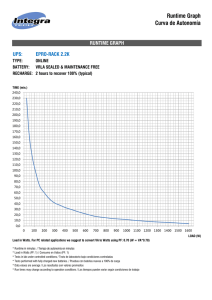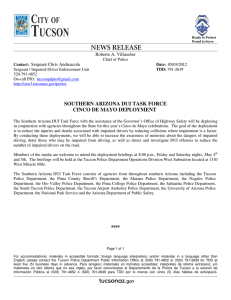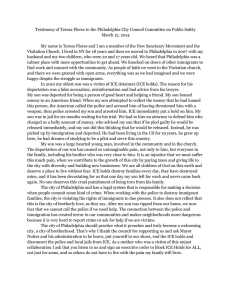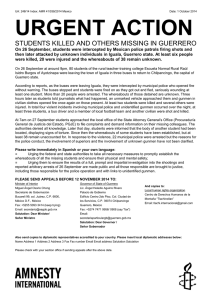Chapter 5: Watts: the Ghetto Erupts
Anuncio
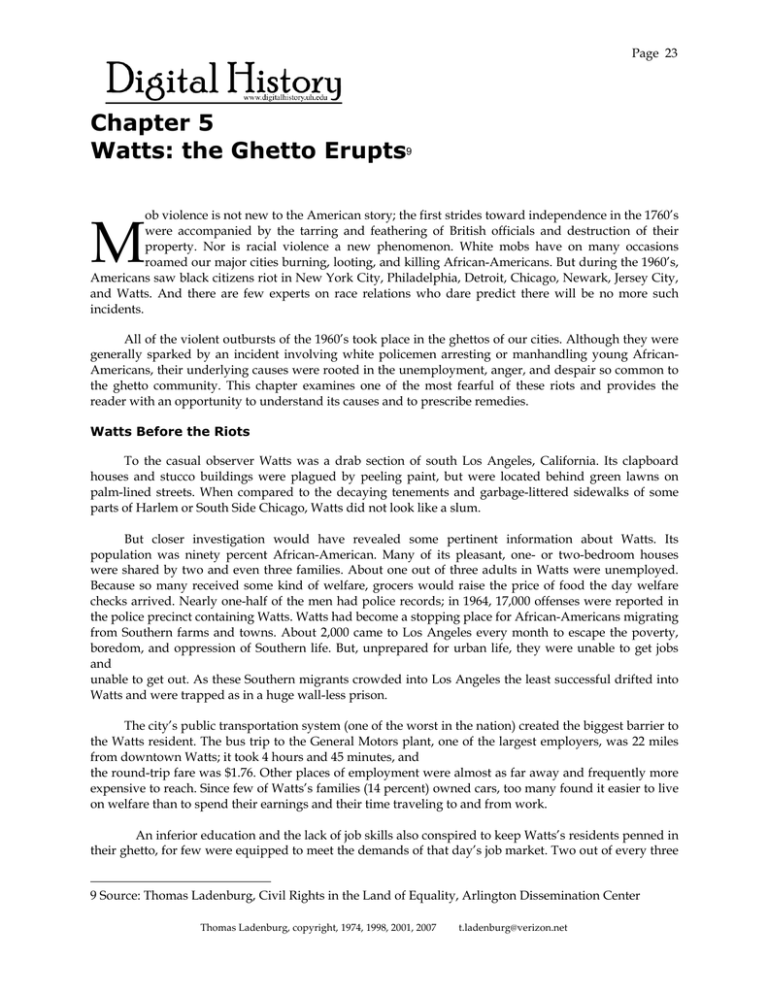
Page 23 Chapter 5 Watts: the Ghetto Erupts9 ob violence is not new to the American story; the first strides toward independence in the 1760’s were accompanied by the tarring and feathering of British officials and destruction of their property. Nor is racial violence a new phenomenon. White mobs have on many occasions roamed our major cities burning, looting, and killing African-Americans. But during the 1960’s, Americans saw black citizens riot in New York City, Philadelphia, Detroit, Chicago, Newark, Jersey City, and Watts. And there are few experts on race relations who dare predict there will be no more such incidents. M All of the violent outbursts of the 1960’s took place in the ghettos of our cities. Although they were generally sparked by an incident involving white policemen arresting or manhandling young AfricanAmericans, their underlying causes were rooted in the unemployment, anger, and despair so common to the ghetto community. This chapter examines one of the most fearful of these riots and provides the reader with an opportunity to understand its causes and to prescribe remedies. Watts Before the Riots To the casual observer Watts was a drab section of south Los Angeles, California. Its clapboard houses and stucco buildings were plagued by peeling paint, but were located behind green lawns on palm-lined streets. When compared to the decaying tenements and garbage-littered sidewalks of some parts of Harlem or South Side Chicago, Watts did not look like a slum. But closer investigation would have revealed some pertinent information about Watts. Its population was ninety percent African-American. Many of its pleasant, one- or two-bedroom houses were shared by two and even three families. About one out of three adults in Watts were unemployed. Because so many received some kind of welfare, grocers would raise the price of food the day welfare checks arrived. Nearly one-half of the men had police records; in 1964, 17,000 offenses were reported in the police precinct containing Watts. Watts had become a stopping place for African-Americans migrating from Southern farms and towns. About 2,000 came to Los Angeles every month to escape the poverty, boredom, and oppression of Southern life. But, unprepared for urban life, they were unable to get jobs and unable to get out. As these Southern migrants crowded into Los Angeles the least successful drifted into Watts and were trapped as in a huge wall-less prison. The city’s public transportation system (one of the worst in the nation) created the biggest barrier to the Watts resident. The bus trip to the General Motors plant, one of the largest employers, was 22 miles from downtown Watts; it took 4 hours and 45 minutes, and the round-trip fare was $1.76. Other places of employment were almost as far away and frequently more expensive to reach. Since few of Watts’s families (14 percent) owned cars, too many found it easier to live on welfare than to spend their earnings and their time traveling to and from work. An inferior education and the lack of job skills also conspired to keep Watts’s residents penned in their ghetto, for few were equipped to meet the demands of that day’s job market. Two out of every three 9 Source: Thomas Ladenburg, Civil Rights in the Land of Equality, Arlington Dissemination Center Thomas Ladenburg, copyright, 1974, 1998, 2001, 2007 [email protected] Page 24 adults had not completed high school; many teenagers dropped out of school while in junior high; one out of eight could neither read nor write; and when an employment agency was finally opened in Watts, only 400 applicants out of 4000 were hired. As automation eliminated jobs once performed by unskilled laborers, unemployment increased and conditions worsened. This was particularly true for African-Americans. National income had soared in the United States since 1959. But African-Americans in Watts had not shared in this prosperity; income there had actually decreased by 8 percent between 1959 and 1965. Although almost cut off from the white world, Watts residents were constantly reminded of it. The TV screen was a window into the world where “whitey” enjoyed the luxuries of life that were denied to the Watts residents. The white policemen were always on the beat or cruising by car, watching out for minority crime. The white landlords collected the rent; the white welfare workers came by to eliminate cheating on welfare; the white politicians made decisions and pronouncements that determined the destiny of Watts residents. And somewhere in the background were the concessions won from the white world by the followers of Martin Luther King, Jr. and other civil rights leaders, but they did not improve the standard of living or the quality of life in Watts. The Spark that Ignited the Powder Keg Marquette Frye, possibly a little drunk, was speeding home when he was stopped by a police car on the corner just two blocks from his home in Watts. Shortly before 7 P.M., Wednesday, August 11, 1965, one officer subjected Frye to a “field” test for drunkenness, which he failed, and told him he would be arrested and the car impounded. A crowd of twenty-five to fifty gathered. Frye smiled and tried to joke with the officer to avoid arrest. Suddenly, Frye’s mother appeared, berated her son, and cursed the policeman, whereupon Frye became furious and called the policeman names, screaming that he wasn’t going to jail. The arresting officer unholstered his pistol. “Go ahead, kill me,” Frye shouted. A second officer pulled out a shotgun and pointed it menacingly at the crowd. Frye was finally handcuffed and hustled into the police car. He continued to struggle, twice tried to escape, and was finally clubbed while in full view of the gathering crowd. By this time the police had called for reinforcements and nearly fifty officers had arrived. The crowd, too, had grown in size, and although still under control, was insulting and taunting the police. An order came for the police to retreat to avoid further trouble. But at this crucial moment, two policemen darted into the crowd and dragged out a woman who, they claimed, had spit on them. At this point, the crowd began scuffling with the police to free the new prisoner. Word spread like wildfire that the police had manhandled a pregnant woman (she wasn’t, though a loose garment she wore made her appear pregnant), and stones were thrown at the retreating officers. The last policemen left under a hail of rocks and debris. When the police returned to the scene, the crowd numbered more than 1500, and bricks, rocks, and bottles flew in all directions. The police tried containing the mob in a two-block area. Their attempts were futile, and their efforts to arrest the ringleaders, or the most violent, only succeeded in stirring the crowd to more violence. Before the evening ended, fifty vehicles, including two fire trucks, were overturned, burned, or damaged; nineteen policemen and sixteen civilians were injured; and thirty-four people, including Marquette Frye, were arrested. Thomas Ladenburg, copyright, 1974, 1998, 2001, 2007 [email protected] Page 25 The Revolution Spreads The next afternoon, the late, outspoken Los Angeles police chief, William Parker, commented on the causes of the riots with this inflammatory remark: One person threw a rock, and then, like monkeys in a zoo, others started throwing rocks.10 That night (Thursday), the rioting was much worse. An African-American salesman, Time™ and a pressed into service by the Los Angeles Times, ssed) decompressor see this picture. gave an account that ran something like this: Every time a car with whites in it came down the street word spread like lightning. “Here comes whitey — get him.” As the older people stood in the background urging them on, boys and girls in their teens and men and women in their twenties, would rush into the streets and pull whites from their autos, beat them, and set fire to their cars. A white couple in their sixties were stopped and beaten as the crowds in the background chanted, “Kill! Kill!” Flying rocks knocked a car driven by whites off course and it plowed into a parked vehicle. The mob swarmed over the whites and beat them so badly that one man’s eye was left hanging out of its socket while the crowd in the background screamed, “Kill! Kill!” Several black ministers intervened and carried the men into an apartment, then called an ambulance and the crowd turned its venom on them: “hypocrites, traitors to your race.” As the crowd was spitting on the ministers, black policemen interfered to rescue them, and drew the mob’s uncontrolled wrath.11 When “whitey” could no longer be found, the crowd began to turn on cars driven by AfricanAmericans. Meanwhile, fires were being set, and rocks and gunfire prevented fire engines from dousing the flames. The crowd had the upper hand and they knew it. The rioters knew that the white police were terrified by their onslaught; they knew that whites were afraid. Whites in other neighborhoods, fearful of the Watts uprising, were running to stores to buy guns. That evening, realizing the mob could not be controlled by the Los Angeles police, Police Chief Parker called for the National Guard. From Rioting to Looting Even the National Guard could not put down the civil disturbance immediately. Jeeps rolled down the streets of Watts, soldiers sat alert with machine guns ready. But no sooner was the mob pacified in one area than rioting and looting broke out again. A New York Times correspondent reported that on Sunday morning he could see a “smattering of people” emerge from side streets as daylight broke. “As the sun rose in the smoke-filled skyline” looting began at “full pace.” The police stayed out of the area except to set roadblocks for firemen. The streets filled with traffic as daylight brought out the curious, the sightseer, and the looter. Looters rushed past one another, from stores to homes, glancing around to see 10New York Times, August 14, 1965, p. 8. 11Quoted in Thomas J. Ladenburg and William S. McFeely, The Black Man in the Land of Equality, (New York: Hayden Book Company, 1969, pp. 157-58. Thomas Ladenburg, copyright, 1974, 1998, 2001, 2007 [email protected] Page 26 what others had taken. The more bold backed their cars right up to stores and loaded furniture, appliances, etc., while their vehicles were blocking traffic. Some ran home with stolen clothes and reappeared in the streets moments later wearing them. Three and fouryear-old children trailed after parents laden with stolen merchandise. The streets were littered with glass, and the splinters from shattering windows cut into arms and feet, drawing blood from the looters who barely took notice. One woman scarcely paused as she walked through a plate-glass window she assumed was already broken. In the background, smoke rose from buildings still on fire; water from fireWatts, August, 1965 fighting equipment ran down the gutters; and the streets were strewn with bricks, bottles, and rocks from the night’s melee. Stores everywhere stood bare. The atmosphere was one of gaiety. Jazz music blared from the nightclubs that had not been damaged because signs like “Soul brother owns this” or “Our Blood” had warned rioters that the establishment was African-American owned. The people laughed and joked; they were thoroughly enjoying themselves; taking what they felt was rightfully theirs anyway, and pleased to have thrown a scare into “whitey” the night before. Assessing Damages By the time it was all over, the five days of rioting had cost thirty-four lives (twenty-nine of them African-American) and left more than 1000 people injured. Property damages have been variously estimated from between 40 to 60 million dollars. About two-thirds of the near 4,000 arrested during the riots either never had police records or had been charged only for petty crimes. This was the aftermath of one of the most destructive riots in our nation’s history. And even before it was over, people had started asking what caused it. The Cause of the Riot Police Chief Parker thought the riot was caused by disrespect for the law. This he blamed on the civil rights movement, which had often preached disobedience to unjust laws: You can’t keep telling them that the Liberty Bell isn’t ringing for them and not expect them to believe it. You can not tell people to disobey the law and not expect them to have a disrespect for the law. You can not keep telling them that they are being abused and mistreated without expecting them to react. 12 Former President Eisenhower also blamed street violence in Watts on the civil rights movement, which he claimed told African-Americans: If we like a law we obey it. If we don’t we are told ‘You can disobey it.’ 12"Races", Time Magazine, LXXXVI (August 20, 1965), p. 19. Thomas Ladenburg, copyright, 1974, 1998, 2001, 2007 [email protected] Page 27 The result, the former President said, is disrespect for all laws, which encouraged the people of Watts to do what they wanted: to loot, to burn, or to destroy. African-American leader Bayard Rustin thought the causes of the Watts riot went far deeper than the effects of the civil rights movement: I think the real cause is that Black youth — jobless, hopeless — do not feel a part of American society. The major job we have is to find them work, decent housing, education, training, so they feel a part of the structure [of society]. People who feel a part of the structure do not attack it. The job of the Negro leadership is to prevent riots before they start.’ 13 President Johnson echoed this argument in a speech delivered before a Southern audience on August 15, 1965. As I have said time and time again, aimless violence finds fertile ground among men imprisoned by the shadowed walls of hatred, coming of age in the poverty of slums, facing their future without education or skills and with little hope of rewarding work. 14 The Aftermath of the Riot California’s governor at the time of the riot was Edmund (Pat) Brown. Brown was in Europe when the violence started, and he arrived in the United States only shortly before Watts quieted down. He ordered an immediate investigation of conditions in Watts and the report issued after 100 days of deliberations advocated: …"revolutionary” programs: massive ‘emergency literacy' drives, a large scale job-training and placement center, new mechanisms for processing complaints against police, and vastly expanded mass transit facilities to permit African Americans to get to jobs around sprawling Los Angeles 15 An aid to Los Angeles’s Mayor Yorty advocated even more help: What we need is something like the old WPA to provide 5,000 to 10,000 jobs for a year. This would take off some of the pressure and give us time to work toward more permanent solutions. 16 Governor Brown asked the California State Legislature to appropriate $61.5 million to enact his program. By March 1966, the money appropriations had not yet been passed. By June, only one of the 232 buildings destroyed in the riot was rebuilt and fewer than ten percent of those damaged had been repaired. Less than $10 million out of the $29 million of antipoverty money promised by President Johnson had filtered down into Watts, and the total assistance provided by the Spring of 1966 consisted of 13"Negro leaders on Violence"", Time Magazine, LXXXVI, August 20, 1965, p. 17 14New York Times, August 16, 1965, p. 17. 15 New York Times, March 20, 1966, Section 4, p. 2. 5 16‘New York Times, November 7, 1965, p. 72 Thomas Ladenburg, copyright, 1974, 1998, 2001, 2007 [email protected] Page 28 only four teen-age canteens, a legal assistance office, a state employment referral office, and aid to a group known as the Westminster Neighborhood Association. Unfortunately, the same conditions that caused that city to explode in August 1965 continued to exist. Indeed, riots again broke out in Watts in March 1966, and again more than twenty years later in response to the verdict following the beating of Rodney King by four policemen after a videotape confirmed many people's belief that police violence against blacks was commonplace. Suggested Student Exercises: 1. Do you think the police should be blamed for mishandling the incident that exploded Watts? 2. The report of the President’s Commission on Urban Unrest blames outbreaks such as those that occurred in Watts on white racism. To what extent is this a more or less accurate interpretation of the causes of the riot than Chief Parker’s or President Eisenhower’s explanations? 3. What do you think is the important lesson to be learned from incidents of civil unrest such as the one that occurred in Watts in 1965? Thomas Ladenburg, copyright, 1974, 1998, 2001, 2007 [email protected]

